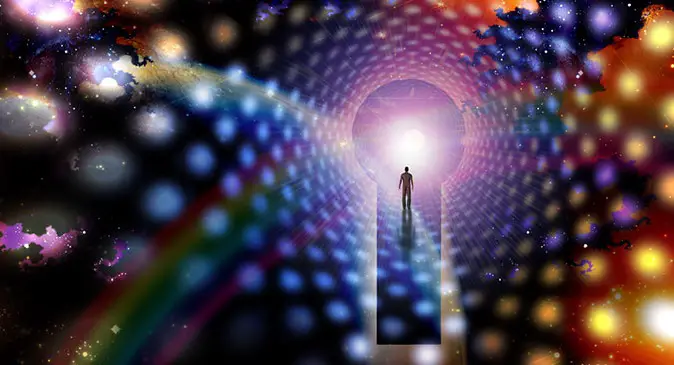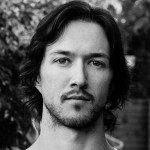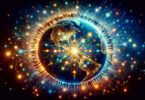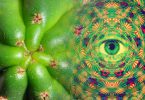19th June 2015
Guest Writer for Wake Up World
Quantum Entanglement
While pre-quantum/Newtonian physics is typically a good approximation for objects much larger than molecules, we know that this worldview is fatally flawed.
To illustrate the point, where initially it was supposed that nonlocal entanglement could not be evinced by anything other than quanta in specially controlled circumstances, we now know it is a fundamental aspect of reality. The entanglement of holmium atoms in a tiny chip of magnetic salt has been unexpectedly observed in the laboratory, showing that “big” things like atoms, and not just photons and electrons (individual quanta), can be entangled.[i] More recently (2011), it was announced by a group of physicists that two diamonds approximately 3 mm in size and separated by about 6 inches were successfully entangled at room temperature.[ii]
[pro_ad_display_adzone id=”110028″]
Previously, it was believed that once things got to the level of atoms and molecules, the universe started acting strictly deterministically again, according to predictable Newtonian laws. This is no longer a scientifically viable view. A review of developments on entanglement research in March 2004 by New Scientist writer Michael Brooks concluded that “Physicists now believe that entanglement between particles exists everywhere, all the time.”[iii]
Widescale or “nonspecific entanglement” has been experimentally validated in many ways. For example, around 1956 Pavel Naumov conducted animal biocommunication studies between a submerged Soviet Navy submarine and a shore research station. These tests involved a mother rabbit and her newborn litter. According to Naumov, scientists put the baby rabbits on board the submarine, but kept the mother rabbit in a laboratory on shore where they implanted electrodes in her brain. When the submarine was submerged, assistants killed the babies one by one. At each precise moment of death, the mother’s brain produced detectable and recordable reactions.[iv] Many examples can be found in Soviet literature dealing with dogs, bears, birds, insects, and fish in conjunction with basic psychotronic (psi) research. The Pavlov Institute in Moscow may have been involved in animal telepathy until 1970.[v] Researchers such as David Wilcock and Richard Hoagland posit that these nonlocal interactions are facilitated by the hyperdimensional torsion/spin waves of the unified field/aether (or gravity, as Wilcock emphasizes in The Source Field Investigations) we are all immersed in. We will look further at torsion and nonlocality between sentient beings soon.
Once, the esteemed physicist Eugene Wigner remarked to Karl Pribram, a board-certified neurosurgeon and professor of psychiatry and psychology, that in quantum physics we no longer have observables (invariants) but only observations. Tongue in cheek, Pribram asked whether that meant that quantum physics is really psychology, at which Wigner beamed and replied, “yes, yes, that’s exactly correct.” “If indeed one wants to take the reductive path, one ends up with psychology, not particles,” says Pribram. “In fact, it is a psychological process, mathematics, that describes the relationships that organize matter. In a non-trivial sense current physics is rooted in both matter and mind.”[vi]
Indeed, one of the main points R.A. Wilson made in Quantum Psychology was that “the laws of the subatomic world and the laws of the human ‘mind’ parallel each other precisely, exquisitely, and elegantly, down to minute details.”[vii]
Wigner, as a physicist, had said that “it was not possible to formulate the laws of quantum mechanics in a fully consistent way without reference to the consciousness…[I]t will remain remarkable in whatever way our future concepts develop, that the very study of the external world led to the conclusion that the content of the consciousness is an ultimate reality.”[viii] Sir Arthur Eddington said that the lesson from physics and especially from quantum mechanics is that insofar as we can describe the world at all we are necessarily describing the structure of our own minds. By collating various forms of scientific thought generated over time, “we obtain the structure known as the physical universe.”[ix]
Wilson further said: “We have found a strange foot-print on the shores of the unknown. We have devised profound theories, one after another, to account for its origin. At last, we have succeeded in reconstructing the creature that made the foot-print. And Lo! It is our own.”[x] Similarly, Goswami has puzzled that according to the new physics, the particle tracks left in cloud chambers are simply extensions of ourselves. The objectified, absolute, Newtonian linear-mechanistic view of the universe is dead. Quantum physics — as per ancient mystical perspectives — simply does not allow the luxury of the concept of the separate observer, because it is meaningless to conceive of the scientist as being separate from his equipment, or anything else. Wheeler has wondered: “May the universe in some sense be brought into being by the participation of those who participate?”[xi]
We are no longer dealing with interactions between two dissimilar entities — “mind” and “matter” — but with a single unified, conscious, holographic entity. Mind is “physical” too if you can rotate into phase with its contents/energies. “From science then, if it must be so,” wrote Paramahansa Yogananda, “let man learn the philosophic truth that there is no material universe; its warp and woof is maya, illusion.”[xii]
Consider what it tells us that a hard science like physics, which set out to investigate the so-called physical world, ended up running headlong into the nonphysical — consciousness. The mystics already knew why this would be so: consciousness is the ultimate reality and the foundation of all existence. It is the sine qua non of the cosmos. It is curious that some “scientifically-minded” types become irate at the mere suggestion that a mystic or occultist could have known something before the venerable institution of science found it out. They seem to forget that scientific research is an implicit acknowledgment of ignorance. If scientists already knew all the answers, scientific research would not exist, because science is, fundamentally, an inquiry; it is not an a priori presumption of omniscience. Science builds models of reality based on what little knowledge of reality it possesses — it does not build reality itself. We need to remember again not to confuse the map with the territory. A scientific theory of something is not the same as the tangible or experiential reality it attempts to describe.
In an interview about his theory of monistic idealism, the interviewer commented to Amit Goswami that “science’s current findings seem to be parallel to the essence of the perennial spiritual teaching.” Goswami responded succinctly: “It is the spiritual teaching. It is not just parallel.”[xiii] Renee Weber, a philosopher at Rutgers University, actually raised the possibility that mysticism may, in a sense, be more committed to the spirit of scientific exploration than science itself.[xiv] In fact, mystics have been described as “the most thoroughgoing empiricists in the history of philosophy.”[xv]
What identifies a mystic then? The true mystic is not a believer or a disbeliever — he or she knows the existential fundamentals, and in getting to the point of knowing, has discarded belief altogether. The mystic has direct insight into the nature of things, as opposed to having to rely on laboratory equipment, equations, theories, speculation, or educated guesses. For the mystic, as far as the fundamental nature of consciousness goes, there is no mystery. For millennia, mystics have known via direct cognition what Bell’s theorem has only fairly recently revealed to the world of science. The mystic experiences the nonlocal, interconnected/entangled nature of consciousness and reality directly, and in doing so, understands it (in a holistic, existential sense).
The mystic knows that human consciousness and our infinitely complex and elegant self-organizing universe did not come into existence through the random interactions of inert matter. This idea has been likened by Stanislav Grof to a tornado blowing through a junkyard and accidentally assembling a 747 jet.[xvi] Noted occultist J.J. van der Leeuw pre-empted Grof almost a century ago, commenting that we might as well believe a heap of bricks could randomly form themselves into a building, if we are going to believe that the blind chance of “natural selection” is responsible for biological life and consciousness.[xvii] It is a ludicrous proposition, in other words. Writing in the 1980s, Francis Crick, the co-(re)discoverer of the DNA molecule, showed the total mathematical implausibility of even a single protein emerging by chance.[xviii] Van der Leeuw added that the data of science are not in any way incompatible with the belief in a creative Intelligence, directing and guiding evolution from within (as opposed to the external “man behind the curtain” scenario advocated by creationists). More than 90 years later this is overwhelmingly the case, as, for example, Yurth’s Self-Organizing Criticality model shows.
A growing point of view among physicists is that there must be a cosmic consciousness pervading the universe. Objects seem to spring into being when measurements are made, and measurements are made by conscious beings. Hence, there must be cosmic consciousness that pervades the universe determining which state we are in. Some, like Nobel laureate Eugene Wigner, have argued that this proves the existence of “God” or some cosmic consciousness. Wigner not surprisingly expressed an interest in the Vedanta philosophy of Hinduism, in which the universe is pervaded by an all-embracing consciousness.[xix] This type of sentiment is becoming increasingly widely held by physicists who are realizing the implications of what quantum mechanics and other fields of research such as parapsychology are telling us.
In order to truly understand what mysticism is and the spirit of it, one has to have encountered a drastically expanded sense of perception or awareness that completely transcends the ordinary waking state of mind and its associated perceptual limitations. If one steps beyond the bounds of permitted thoughts allowed by the materialistic paradigm, one learns an awful lot about just how limited and myopic this reductionist view of life actually is, and how much fact it must ignore and deny in order to maintain its own survival. Please note: I used to be something of a materialist myself (philosophically). The problem is that this belief structure can only survive within very narrow experiential and investigative parameters that not every human life can (or will) facilitate. If it could, everyone in the so-called developed world would be a materialist, or would have been, were it not for the advent of quantum mechanics. So, is any talk of or related to mysticism “pseudo-science” by definition? Categorically, no. Grof (for one) agrees, stating that the “pedestrian consciousness and world-view” have simply not caught up with mysticism or modern physics.[xx]
Another common misconception is that mysticism is analogous or related to Western conceptions of religion or religious zeal and/or faith. But the mystical experience is not a moment of intense faith; it is a moment of intensely deep experience beyond this ordinary world and/or its normal sense impressions. Do you have faith in the existence of the chair you are sitting on? No, you simply observe and sense that the chair exists, otherwise you would have landed rather sharply on the floor! By your experience you know it exists and can leave it at that. In contrast, simply believing in the chair would probably not be enough to hold you up off the floor, no matter how lovely and detailed a 2D schematic of it you might have drawn up! Thus, mysticism is based first and foremost on direct and lucid experience of expanded and altered states of awareness/consciousness and thus asks no blind faith. (A mystic also knows not to confuse the map with the territory.) In this sense, we can see that mysticism does not consist in believing in some abstract faith-based dogma.
Donald DeGracia is a biochemical researcher in the field of cerebral ischemia and reperfusion. In his excellent book Beyond the Physical, he wrote:
Mysticism is the true spiritual approach, it is the true way to religion, [which] in the West [today] is but a watered-down, overly rigid, dogmatic and institutionalized vestige of ancient expressions of the mystical experience. The true mystical experience defies the mind at all of its levels…and brings into direct comprehension the…living unity of all existence.[xxi]
Mysticism expands consciousness, deepens awareness, and develops wisdom, whereas organized religion — having been “de-mysticized” — has a tendency towards often (though not always) achieving the complete opposite effect, especially in its literalistic fundamentalist and extremist forms. This applies much less to its more progressive streams, which appear to be moving in a more experiential and enlightened direction, such as is the way in mysticism and true occultism. In other words, even that most intellectually rigid and stagnant of institutions, mainstream religion, is very gradually creating new models of “God” and reality. It still has not really realized its mystical roots though, still suffering institutionalized amnesia.
Science’s childish attitude towards what it conceives to be mysticism has in many ways been as bad as religion’s attitude towards it. To both institutions, mysticism has traditionally been “the devil… Yet the mocking presumptuousness of modern science and philosophy towards occultism and mysticism is only an admission of their ignorance and insecurity in the light of knowledge and wisdom that neither possesses.”[xxii]
In the late 1970s, Fritjof Capra said this, in simplifying and reconciling the different approaches taken by mystics and scientists: “Mystics understand the roots but not the branches, scientists understand the branches but not the roots.”[xxiii] Evelyn Underhill put it this way: “even the report of the greatest contemplative saint is much like that of the wise shepherd, who can tell us much about the weather, but nothing about meteorology.”[xxiv] What mystics understand the roots of is this: the fundamental nature of reality itself and the fundamental nature of consciousness (same thing). Mystics are actually much more inclined towards understanding areas of inquiry such as quantum physics than many otherwise intelligent people are. They have an experiential advantage with nonlocality, for a start. There is nothing airy-fairy or flaky about a mystic. It is an awareness characterized by deep insight and clarity of thought, not a lack of it. In fact, Capra wrote an entire book on the similarities between mysticism and physics. In The Tao of Physics he explained that, while the mystic begins his exploration from the inner realm and the physicist begins from the outer, they both ultimately reach the same destination: awareness of the fundamental unity between all things and events.[xxv]
Modern science tells us that the world of supposedly solid matter, as presented to us by the standard five senses, is an illusion. This is, of course, the view taken by mystics ever since there was such a thing as a mystic. How else is it that the deeper we attempt to peer into supposedly solid matter, the more empty space we find? Seemingly inert matter proves, upon closer inspection, to be very much alive and in constant motion; Larson’s proposition — and he was not alone — was that the only thing that really exists in our space-time is motion. Apparent solidity is merely a function of a particular mode of perception, not an absolute truth.
The mystic’s outlook encompasses the materialist’s perspective and extends beyond, much as metaphysics both includes and transcends physics. As Taimni said in The Science of Yoga, the higher viewpoint includes and enhances the lower, while placing the lower in its proper perspective. “Expansion of consciousness means inclusion of more and more and exclusion of nothing.”[xxvi] Thus, the mystic’s sense of reality places the world of appearances in its proper context, giving one the awareness of the difference between illusion and reality/truth.
References:
- [i] See Brooks. McTaggart details these and related experiments extensively in The Intention Experiment.
- [ii] Schoch, Time, Entanglement & Consciousness, New Dawn Special Issue 6(4).
- [iii] Brooks.
- [iv] Ostrander & Schroeder, Psychic Discoveries Behind the Iron Curtain, 33–4.
- [v] Defence Intelligence Agency, Soviet and Czchechoslovakian Parapsychology Research, September 1975.
- [vi] Pribram, Consciousness Reassessed.
- [vii] Wilson, Quantum Psychology, 43.
- [viii] www.projects.science.uu.nl/igg/jos/foundQM/wigner.pdf
- [ix] Wilson, Cosmic Trigger, vol. 1.
- [x] Ibid.
- [xi] Pinchbeck, 49.
- [xii] Yogananda, 228.
- [xiii] Hamilton, Scientific Proof of the Existence of God.
- [xiv] Radin, The Conscious Universe, 305.
- [xv] LeShan, 62.
- [xvi] Grof, The Holotropic Mind, 5.
- [xvii] See van der Leeuw, Ch. 5.
- [xviii] Narby, 75–6.
- [xix] Kaku, Physics of the Impossible, 243.
- [xx] Grof, LSD Psychotherapy, 128.
- [xxi] DeGracia, Beyond the Physical, 16.
- [xxii] Ibid., 17.
- [xxiii] See Capra, The Tao of Physics, 339.
- [xxiv] Underhill, 31.
- [xxv] Capra, 338.
- [xxvi] Taimni, 167–8.
Previous articles by Brendan D. Murphy:
- Quantum Phase: Time, Parallel Realities and The Brain
- Thoughts Through Space: a Pioneering Long-Distance Telepathy Experiment
- Who Thinks Your Thoughts?
- Junk DNA: Our Interdimensional Doorway to Transformation
- The Virtual Aether – “Empty Space” Gets an Upgrade
- New Awareness for a New Earth – Paradigms and Culture Minds
- The Belief Effect in Psychokinesis – Psychics, Skeptics and Science
- Time and Torsion in a Conscious, Holographic Universe
- The Question of Consciousness
About the author:
Critically acclaimed author and co-founder of Global Freedom Movement, Brendan D. Murphy is a leading expositor of the new paradigm of integrated science and spirituality/sovereignty. He is a passionate advocate of accelerated conscious evolution through sound-based DNA/kundalini activation and intentional harnessing of the life-supporting (negentropic) aetheric forces of consciousness, while also having experience in psychoenergetic and belief change modalities.
For Brendan, compassionately hacking the Matrix is more than just sport, it’s a way of life. He lives and breathes it, taking a stand for truth and beckoning others to join him on the path of informed, compassionate, and courageous living. Understanding that the outer world always holographically reflects the inner, Brendan believes idle research and information absorption is not enough — we must embody our ideals now and transmute knowledge into wisdom through willful and gutsy application.
“Enough of the slave species legacy we’ve been playing out for millennia! It’s time to rediscover sovereignty, infinite consciousness and our multi-dimensional selves. Evolution is calling. Will we answer?”
You can connect with Brendan at BrendanDMurphy.net and GlobalFreedomMovement.org.
The Grand Illusion
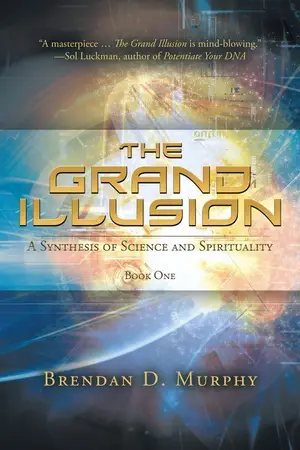 Did you know that modern neuroscience considers the brain as a receiver of consciousness rather than the generator of it?
Did you know that modern neuroscience considers the brain as a receiver of consciousness rather than the generator of it?
Brendan D. Murphy’s book “The Grand Illusion : a Synthesis of Science & Spirituality? synthesizes the paranormal with today’s hard science, breaking through the outmoded world-view that we are just powerless little “meat computers”. Here, new and expansive vistas of possibility are laid bare, and the forces and energies produced by our consciousness that act on the world around us are blown open for your understanding.
Get ready for an introduction to the mysterious “fifth force” known to science – a “carrier wave” of consciousness that can travel at speeds far exceeding light. With the knowledge that we are incredible and immortal spiritual beings temporarily inhabiting a dream-like, multidimensional, holographic reality, we can indeed begin to turn life on this planet – which, for many, is a virtual nightmare – into The Grand Illusion.
Are you ready to meet yourself? “The Grand Illusion: a Synthesis of Science & Spirituality? is available at BrendanDMurphy.net and Amazon/The Grand Illusion.
[pro_ad_display_adzone id=”110027″]

